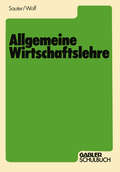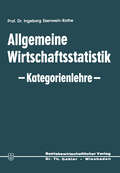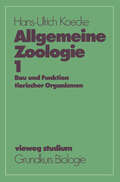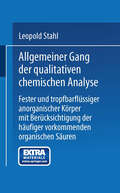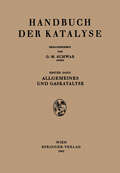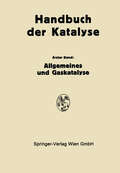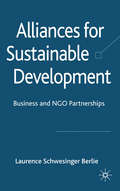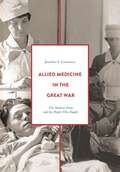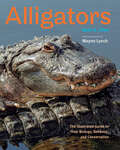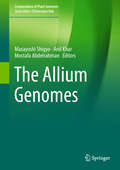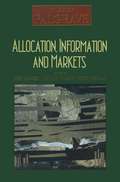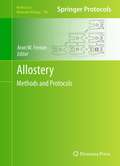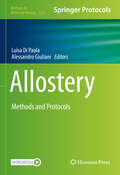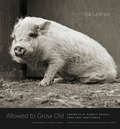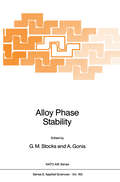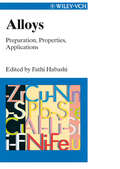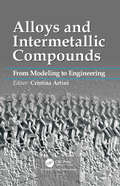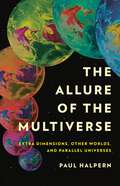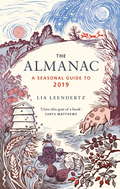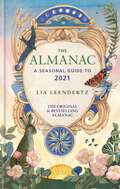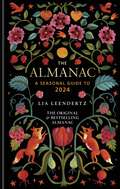- Table View
- List View
Allgemeine Wirtschaftslehre
by Werner SauterDieses Buch umfaßt sämtliche Lerninhalte, die in den Rahmenlehrplänen der Kultusministerkon ferenz für das Fach "Allgemeine Wirtschaftslehre" in den Ausbildungsberufen Bankkaufmann Industriekaufmann Kaufmann im Groß-und Außenhandel sowie Versicherungskaufmann gefordert werden. Der Schüler soll deshalb mit diesem Buch das zum Urteilen, Handeln und Entscheiden notwendige wirtschaftliche und rechtliche Grundwissen erwerben; befähigt werden, konkrete wirtschaftliche Sachverhalte, Entwicklungen und Spannungsver hältnisse zu verstehen; wirtschafts- und sozialpolitische Zielvorstellungen kennenlernen und Maßnahmen zu ihrer Verwirklichung verstehen. Diese anspruchsvolle Zielsetzung der Lehrpläne ist im Unterricht in der zur Verfügung stehen den Zeit nur schwer zu erfüllen. Das Ziel dieses Buches besteht deshalb darin, durch absolute Lehrplangerechtigkeit des Lerninhaltes sowie der Lernzielkontrollen dem Lehrer und dem Schü ler ein Lernmittel an die Hand zu geben. das dabei hilft. diesen Anforderungen gerecht zu wer den. Aus der Zielsetzung dieses Lehrbuches ergeben sich die wesentlichen Merkmale seiner Konzep tion: Der Lehrstoff entspricht in Inhalt, Aufbau und Gliederung voll dem Lehrplan; die Tiefe des Lernstoffes, die Beispiele und die Lernzielkontrollen richten sich ausschließlich nach der im Lehrplan geforderten Lernzielebene und erleichtern damit dem Lehrer und dem Schüler das Auswahlproblem; durch besonders gekennzeichnete. weiterführende Aufgaben gibt das Buch dem Lehrer trotz dem die Möglichkeit. die einzelnen Themen vertiefend zu behandeln; zu Beginn jeder Lerneinheit werden die Lernziele aufgeführt; durch sinnvolle Eingangsbeispiele, Problemstellungen und Denkanstöße wird der Schüler zu dem jeweiligen Thema hingeführt; es werden u. a. Gesetzestexte zitiert.
Allgemeine Wirtschaftsstatistik — Kategorienlehre — (Die Wirtschaftswissenschaften)
by Ingeborg Esenwein-RotheAllgemeine Zoologie: Bau und Funktion tierischer Organismen (vieweg studium; Grundkurs Biologie #1)
by Hans-Ulrich KoeckeAllgemeiner Gang der qualitativen chemischen Analyse fester und tropfbarflüssiger anorganischer Körper mit Berücksichtigung der häufiger vorkommenden organischen Säuren
by Leopold StahlAllgemeines und Gaskatalyse
by M. Bodenstein E.J. Buckler J.A. Christiansen E. Cremer W. Jost M. Kilpatrick H. Mark A. Mittasch R.G.W. Norrish G.-M. Schwab R. SimhaDieser Buchtitel ist Teil des Digitalisierungsprojekts Springer Book Archives mit Publikationen, die seit den Anfängen des Verlags von 1842 erschienen sind. Der Verlag stellt mit diesem Archiv Quellen für die historische wie auch die disziplingeschichtliche Forschung zur Verfügung, die jeweils im historischen Kontext betrachtet werden müssen. Dieser Titel erschien in der Zeit vor 1945 und wird daher in seiner zeittypischen politisch-ideologischen Ausrichtung vom Verlag nicht beworben.
Allgemeines und Gaskatalyse
by G. M. SchwabDieser Buchtitel ist Teil des Digitalisierungsprojekts Springer Book Archives mit Publikationen, die seit den Anfängen des Verlags von 1842 erschienen sind. Der Verlag stellt mit diesem Archiv Quellen für die historische wie auch die disziplingeschichtliche Forschung zur Verfügung, die jeweils im historischen Kontext betrachtet werden müssen. Dieser Titel erschien in der Zeit vor 1945 und wird daher in seiner zeittypischen politisch-ideologischen Ausrichtung vom Verlag nicht beworben.
Alliances for Sustainable Development: Business and NGO Partnerships
by L. BerlieA lively and hands-on exploration of corporate-NGO alliances. It offers original insight to understand why alliances exist and to what end. It also looks into the asymmetries between partners and dwells on three crucial aspects of alliances management : alliance capacity development, stakeholder involvement and alliance metrics.
Allied Medicine in the Great War: The Medical Front and the People Who Fought
by Jennifer S. LawrenceThis book provides an overview of the history of allied medicine in the Great War. Based on both primary research and secondary literature, it offers a clear and concise account of medical treatment during the Great War, exploring the advancements of the period and the human experience of the medical war.As well as covering European medical work, the book draws on a range of American primary sources and texts in order to address the American medical experience of the First World War, an area that has been neglected by the existing literature.This is an accessible exploration of the medical war, the people involved, and its impact. It is an essential text for undergraduate and postgraduate students of History taking courses on medicine in war, the history of medicine or the Great War.
Allied Medicine in the Great War: The Medical Front and the People Who Fought
by Jennifer S. LawrenceThis book provides an overview of the history of allied medicine in the Great War. Based on both primary research and secondary literature, it offers a clear and concise account of medical treatment during the Great War, exploring the advancements of the period and the human experience of the medical war.As well as covering European medical work, the book draws on a range of American primary sources and texts in order to address the American medical experience of the First World War, an area that has been neglected by the existing literature.This is an accessible exploration of the medical war, the people involved, and its impact. It is an essential text for undergraduate and postgraduate students of history taking courses on medicine in war, the history of medicine or the Great War.
Alligators: The Illustrated Guide to Their Biology, Behavior, and Conservation
by Kent A. VlietFew scenes put the senses on edge more than a submerged alligator, only eyes and snout showing, when peering across a southern lake on a misty morning. An iconic American predator, these reptiles grow to thirteen feet or more and can live as long as humans. Alligators are complex creatures, capable of terrific attacks and yet tending to their young in the same gentle way a mother duck looks after her brood. Once extremely numerous, alligators came close to extinction in the twentieth century, but thanks to conservation efforts have since made a comeback, reclaiming their rightful place as the monarchs of the southern wetlands.In this fascinating account, richly illustrated with more than 150 photographs from award-winning wildlife photographer Wayne Lynch, expert zoologist Kent A. Vliet introduces readers to the biology, ecology, and natural history of the American alligator. Sharing nuanced depictions of their hidden lives that will forever change the way you think of these giant reptiles, the book• combines captivating storytelling with the most current scientific facts• chronicles the life cycle of the alligator• explains why the alligator's precise anatomy and physiology make it so successful• covers a wide range of topics, from courtship and reproduction to communication, basking, nest-building, and hunting• reveals the alligator's sophisticated social life in detail• evaluates the alligator's environmental role as a keystone species• examines the complicated relationship between alligators and people
The Allium Genomes (Compendium of Plant Genomes)
by Masayoshi Shigyo Anil Khar Mostafa AbdelrahmanThis book describes the latest advances in Allium genome research. Allium includes plant species known for their huge nuclear genome size, which makes them ideal for somatic chromosome observations in high school experiments. In order to advance the genome analysis of A. cepa and its functional study, scientists in international research collaborations have developed several types of artificially manipulated genetic stocks and analyzed them using modern technologies. The Allium vegetable crop includes garlic, shallot, wakegi onion, Japanese bunching onion, and rakkyo. Bulb onion is one of the world's most important Allium commercial crops, with an estimated annual production of 85.8 million tons in 2013, and ranking third after tomato and watermelon in terms of global vegetable crops.
Allocation, Information and Markets (The New Palgrave)
by John Eatwell Murray Milgate Peter NewmanThis is an extract from the 4-volume dictionary of economics, a reference book which aims to define the subject of economics today. 1300 subject entries in the complete work cover the broad themes of economic theory. This volume concentrates on the topic of allocation information and markets.
Allosteric Regulatory Enzymes
by Thomas W. TrautThis book covers the most recent developments in the analysis of allosteric enzymes and provides a logical introduction to the limits for enzyme function as dictated by the factors that are limits for life. The book presents a complete description of all the mechanisms used for changing enzyme activity. It is extensively illustrated to clarify kinetic and regulatory properties. Eight enzymes are used as model systems after extensive study of their mechanisms. Wherever possible, the human form of the enzyme is used to illustrate the regulatory features.
Allostery: Methods and Protocols (Methods in Molecular Biology #796)
by Aron W. FentonDespite considerable variability within the scientific community, allosteric regulation can best be defined functionally as how a macromolecule binds one ligand differently when a second ligand is or is not pre-bound to the macromolecule, which constitutes a vital aspect of protein structure/function. In Allostery: Methods and Protocols, expert researchers in the field provide key techniques to investigate this biological phenomenon. Focusing on heterotropic systems with some coverage of homotropic systems, this volume covers the monitoring of allosteric function, allosteric conformational changes, and allosteric changes in protein dynamics/sub-population distribution, as well as topics such as macromolecular and ligand engineering of allosteric functions and computational aids in the study of allostery. Written in the highly successful Methods in Molecular Biology™ series format, the chapters include the kind of detailed description and implementation advice that is crucial for getting optimal results in the laboratory. Thorough and intuitive, Allostery: Methods and Protocols aids scientists in continuing to study ligand-induced, through-protein effects on protein function (ligand binding/catalysis), a phenomenon that is well recognized through the history of the life sciences and very poorly understood at the molecular level.
Allostery: Methods and Protocols (Methods in Molecular Biology #2253)
by Luisa Di Paola Alessandro GiulianiThis volume explores the basic issues of “allostery” and “network” that are fundamental to studying this field. Chapters in this book look at how the basic “machine-like” proteins, that are similar to “human machines,” need to be organized, architecturally, to relate to different organizational layers. Chapters cover topics such as methodological/computational factors focused on links between allostery and network formalism; the presence of oscillating modes transversing the structure and underlying network wiring of the allosteric process; the “action at distance” by transduction of signals across an organized network structure; and the P53 protein located at the cross-road of cell cycle regulation, genome integrity, and cancer development. Written in the highly successful Methods in Molecular Biology series format, chapters include introductions to their respective topics, lists of the necessary materials and reagents, step-by-step, readily reproducible laboratory protocols, and tips on troubleshooting and avoiding known pitfalls.Thorough and practical, Allostery: Methods and Protocols is a valuable resource for any scientists and researcher interested in learning more about this developing field.
Allowed to Grow Old: Portraits of Elderly Animals from Farm Sanctuaries
by Isa LeshkoThere’s nothing quite like a relationship with an aged pet—a dog or cat who has been at our side for years, forming an ineffable bond. Pampered pets, however, are a rarity among animals who have been domesticated. Farm animals, for example, are usually slaughtered before their first birthday. We never stop to think about it, but the typical images we see of cows, chickens, pigs, and the like are of young animals. What would we see if they were allowed to grow old? Isa Leshko shows us, brilliantly, with this collection of portraits. To create these portraits, she spent hours with her subjects, gaining their trust and putting them at ease. The resulting images reveal the unique personality of each animal. It’s impossible to look away from the animals in these images as they unforgettably meet our gaze, simultaneously calm and challenging. In these photographs we see the cumulative effects of the hardships of industrialized farm life, but also the healing that time can bring, and the dignity that can emerge when farm animals are allowed to age on their own terms. Each portrait is accompanied by a brief biographical note about its subject, and the book is rounded out with essays that explore the history of animal photography, the place of beauty in activist art, and much more. Open this book to any page. Meet Teresa, a thirteen-year-old Yorkshire Pig, or Melvin, an eleven-year-old Angora Goat, or Tom, a seven-year-old Broad Breasted White Turkey. You’ll never forget them.
Allowed to Grow Old: Portraits of Elderly Animals from Farm Sanctuaries
by Isa LeshkoThere’s nothing quite like a relationship with an aged pet—a dog or cat who has been at our side for years, forming an ineffable bond. Pampered pets, however, are a rarity among animals who have been domesticated. Farm animals, for example, are usually slaughtered before their first birthday. We never stop to think about it, but the typical images we see of cows, chickens, pigs, and the like are of young animals. What would we see if they were allowed to grow old? Isa Leshko shows us, brilliantly, with this collection of portraits. To create these portraits, she spent hours with her subjects, gaining their trust and putting them at ease. The resulting images reveal the unique personality of each animal. It’s impossible to look away from the animals in these images as they unforgettably meet our gaze, simultaneously calm and challenging. In these photographs we see the cumulative effects of the hardships of industrialized farm life, but also the healing that time can bring, and the dignity that can emerge when farm animals are allowed to age on their own terms. Each portrait is accompanied by a brief biographical note about its subject, and the book is rounded out with essays that explore the history of animal photography, the place of beauty in activist art, and much more. Open this book to any page. Meet Teresa, a thirteen-year-old Yorkshire Pig, or Melvin, an eleven-year-old Angora Goat, or Tom, a seven-year-old Broad Breasted White Turkey. You’ll never forget them.
Alloy Phase Stability (NATO Science Series E: #163)
by G. M. Stocks A. GonisOne of the ultimate goals of materials research is to develop a fun damental and predictive understanding of the physical and metallurgical properties of metals and alloys. Such an understanding can then be used in the design of materials having novel properties or combinations of proper ties designed to meet specific engineering applications. The development of new and useful alloy systems and the elucidation of their properties are the domain of metallurgy. Traditionally, the search for new alloy systems has been conducted largely on a trial and error basis, guided by the skill and intuition of the metallurgist, large volumes of experimental data, the principles of 19th century thermodynamics and ad hoc semi-phenomenological models. Recently, the situation has begun to change. For the first time, it is possible to understand the underlying mechanisms that control the formation of alloys and determine their properties. Today theory can begin to offer guidance in predicting the properties of alloys and in developing new alloy systems. Historically, attempts directed toward understanding phase stability and phase transitions have proceeded along distinct and seemingly diverse lines. Roughly, we can divide these approaches into the following broad categories. 1. Experimental determination of phase diagrams and related properties, 2. Thermodynamic/statistical mechanical approaches based on semi phenomenological models, and 3. Ab initio quantum mechanical methods. Metallurgists have traditionally concentrated their efforts in cate gories 1 and 2, while theoretical physicists have been preoccupied with 2 and 3.
Alloys: Preparation, Properties, Applications
by Fathi HabashiIn industry very few metals are used in their pure form; the majority are employed as a combination of a metal with other metals, nonmetals or metalloids. In this way some specific properties are improved, making the alloy more attractive than the pure metal. The present work comprises essential information on alloys in one compact volume. Classification, properties, preparation, applications, and economic aspects are discussed for alloy steels, primary-metal alloys, light-metal alloys, and some other alloy systems. The work is based on more than 30 articles from Ullmann's Encyclopedia of Industrial Chemistry and represents the effort of over 60 specialists. It supplies hundreds of top-quality illustrations, diagrams, and charts and provides hand-picked references for further study. An introductory overview of the subject is provided by the editor. The book is a handy yet authoritative reference work for the practicing metallurgist, but also for physical metallurgists, engineers and scientists in industry.
Alloys and Intermetallic Compounds: From Modeling to Engineering
by Cristina ArtiniThis book focuses on the role of modeling in the design of alloys and intermetallic compounds. It includes an introduction to the most important and most used modeling techniques, such as CALPHAD and ab-initio methods, as well as a section devoted to the latest developments in applications of alloys. The book emphasizes the correlation between modeling and technological developments while discussing topics such as wettability of Ultra High Temperature Ceramics by metals, active brazing of diamonds to metals in cutting tools, surface issues in medicine, novel Fe-based superconductors, metallic glasses, high entropy alloys, and thermoelectric materials.
Alloys and Intermetallic Compounds: From Modeling to Engineering
by Cristina ArtiniThis book focuses on the role of modeling in the design of alloys and intermetallic compounds. It includes an introduction to the most important and most used modeling techniques, such as CALPHAD and ab-initio methods, as well as a section devoted to the latest developments in applications of alloys. The book emphasizes the correlation between modeling and technological developments while discussing topics such as wettability of Ultra High Temperature Ceramics by metals, active brazing of diamonds to metals in cutting tools, surface issues in medicine, novel Fe-based superconductors, metallic glasses, high entropy alloys, and thermoelectric materials.
The Allure of the Multiverse: Extra Dimensions, Other Worlds, and Parallel Universes
by Paul Halpern&“A rich and rewarding history of one of the most astounding ideas in physics and astronomy&” (Marcia Bartusiak) – that the universe we know isn&’t the only one Our books, our movies—our imaginations—are obsessed with extra dimensions, alternate timelines, and the sense that all we see might not be all there is. In short, we can&’t stop thinking about the multiverse. As it turns out, physicists are similarly captivated. In The Allure of the Multiverse, physicist Paul Halpern tells the epic story of how science became besotted with the multiverse, and the controversies that ensued. The questions that brought scientists to this point are big and deep: Is reality such that anything can happen, must happen? How does quantum mechanics &“choose&” the outcomes of its apparently random processes? And why is the universe habitable? Each question quickly leads to the multiverse. Drawing on centuries of disputation and deep vision, from luminaries like Nietzsche, Einstein, and the creators of the Marvel Cinematic Universe, Halpern reveals the multiplicity of multiverses that scientists have imagined to make sense of our reality. Whether we live in one of many different possible universes, or simply the only one there is, might never be certain. But Halpern shows one thing for sure: how stimulating it can be to try to find out.
The Almanac: A Seasonal Guide to 2019
by Lia LeendertzTHE ORIGINAL & BESTSELLING ALMANAC 'I love this gem of a book' - Cerys Matthews 'This book is your bible' - The Independent '...it already feels like an annual necessity' - India Knight 'Joyous' - Allan Jenkins 'Updated for 2019 with more lovely ideas to celebrate the seasons' - Gardens Illustrated'A charming book. This is a real gem of a gift' - Sunday Express, S Magazine. A perfect toolkit connecting with the world around us and the year ahead as it unfolds - all in a compact and pocket size that just begs you to pick it up and browse - Reckless Gardener or Its range of information and depth of understanding of our seasons is priceless - Reckless GardenerThe Almanac: A Seasonal Guide to 2019 reinvents the tradition of the rural almanac for a new audience. It gives you the tools and inspiration you need to celebrate, mark and appreciate each month of the year in your own particular way. Divided into the 12 months, a set of tables each month gives it the feel and weight of a traditional almanac, providing practical information that gives access to the outdoors and the seasons, perfect for expeditions, meteor-spotting nights and beach holidays. There are also features on each month's unique nature, such as the meteor shower of the month, beehive behaviour, folklore and stories, seasonal recipes and charts tracking moon phases and tides. Why not try identifying trees by their bare buds in January; Enjoy Buttermilk scones with orangle blossom & honey butter in June; Discover the Chinese New Year story of 'The great race' in February.You will find yourself referring to the almanac all year long, revisiting it again and again, and looking forward to the next edition as the year draws to a close.Praise for The Almanac: A Seasonal Guide to 2018:'The perfect companion to the seasons' - India Knight'A richly layered book of events, celebrations and everyday information that together create a beautiful, fascinating resource . . . In the single month I've had my hands on it, the book has quietly "worked".' - Telegraph'Beautifully written, this pocket-sized guide is a labour of love and will remind you to appreciate little moments throughout the year.' - Gardens Illustrated'Elegant . . . an ideal stocking filler.' - The English Garden
The Almanac: A Seasonal Guide to 2021
by Lia LeendertzWelcome to The Almanac: A Seasonal Guide to 2021. If you are new to The Almanac then welcome; if you are a regular reader then hello! The Almanac is about celebrating the unfolding year in all its various facets. The old dependables which I include every year are back: moon phases, sun rises and sets, tide time tables and the sky at night. As ever there are seasonal recipes and monthly gardening tips for the flower and vegetable garden too, as well as a bit of folklore, and nature and a song for each month.This year's edition has a theme: movement, migration and pilgrimage. This was not a reaction to the unsettling events of last year - it was half written by the time Covid-19 hit - but writing it from lockdown did give me a heightened appreciation of the way in which Britain and Ireland have always and continue to be places of movement, and are intimately connected to the rest of the world. You will find within this book migration tales for each month of this year, but I have also searched out seasonal tales of human movement, and included a pilgrimage for each month, some ancient, some current, all underlining the spiritual benefits of putting one foot in front of the other. Every month I have included a method of navigating using the stars, sun or moon, so you can find your way around in the dark (or just look out of your window and know where south is). And our monthly folk songs are all shanties this year, work songs with movement at their very heart, created to coordinate muscle power to drive sailing ships backwards and forwards across the Atlantic Ocean, and containing influences from the eastern seaboard of the US down to the Caribbean and beyond mixed with British and Irish folk traditions. These songs are stitched through with movement and travel, as is this Almanac.PRAISE FOR THE ALMANAC: A SEASONAL GUIDE'The perfect companion to the seasons' - India Knight'This book is your bible' - The Independent'An ideal stocking filler' - The English Garden'I love this gem of a book' - Cerys Matthews'Indispensable' - Sir Bob Geldof
The Almanac: A Seasonal Guide To 2018 (Almanac)
by Lia LeendertzTHE ORIGINAL & BESTSELLING ALMANACReconnect with the seasons in Britain and Ireland with this month-by-month guide to the world around us - including tide tables, sunrises and moon phases; garden feasts, wildlife and folklore; seasonal recipes, snacks and more.The Almanac: A Seasonal Guide to 2024 gives you the tools and inspiration you need to celebrate, mark and appreciate each month of the year in your own particular way.Divided into the 12 months, a set of tables each month gives it the feel and weight of a traditional almanac, providing practical information that gives access to the outdoors and the seasons, perfect for expeditions, meteor-spotting nights and beach holidays. This year's edition focuses on the natural wonders of the garden, celebrating the beautiful flora and fauna at your doorstep. There are also features on each month's unique nature, plus a flower and a snack of the month.You will find yourself referring to The Almanac all year long, revisiting it again and again, and looking forward to the next edition as the year draws to a close.PRAISE FOR THE ALMANAC:'Lia Leendertz's classic almanac never fails to delight' - The Herald'It's a perfect Christmas present' - Allan Jenkins, The Observer'The perfect companion to the seasons' - India Knight'Indispensable' - Sir Bob Geldof'This book is your bible' - The Independent'I love this gem of a book' - Cerys Matthews
